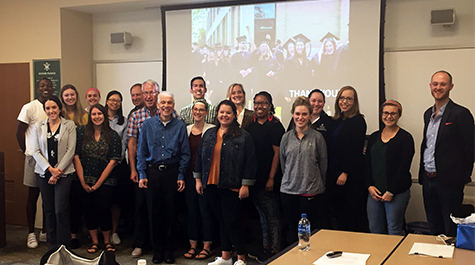International guest lecturer visits Higher Education Administration Branding in Higher Education class
Students from the School of Education’s Higher Education program had the opportunity to learn and experience how universities are branding themselves. On Wednesday, September 18, the Branding in Higher Education class taught by Dr. Jeffrey Papa welcomed an international guest lecturer, Vice President Robert Skillen, from the University of New Brunswick (UNB), who discussed UNB’s systematic and robust branding journey.
The UNB is the oldest English-language university in Canada, founded in 1785. Currently, it is the largest post-secondary institution in New Brunswick with over 10,000 students across two campuses, one in Fredericton and the other in Saint John. In his lecture, Skillen shared why the UNB needed to participate in a university-wide rebranding effort and how the university addressed issues of brand image and campus engagement during its branding process.
Branding is a hot topic among higher education marketers and communicators. Developing a distinctive brand position is increasingly important for higher education institutions within a competitive marketplace. Many institutions, including UNB, are beginning to reflect the branding processes outside the educational arena.
Inviting higher education institutional administrators into the classroom allows students to understand many of the challenges colleges and universities are facing and the steps institutions are taking to respond to these challenges.
“Having someone brought into class to represent the application and real-world situations of what we are reading, learning and discussing in class every week is truly invaluable,” said Cody Watson, a second-year master’s student in Higher Education. “We were able to hear from a professional who lived and led the process that we read about and showcase for us just how much thought, effort and work goes into an institutional branding project.”
Other students shared the same sentiments about being able to listen to an administrator that has real-world experience with implementing a long-term branding project, a concept they read about and discuss in class.
“Skillen’s ability to walk us through the questions UNB asked, the way UNB managed differing opinions about the project and the impact it had on the university's enrollment and morale was fascinating,” Dayna Scarberry, a first-year master’s student, said.
Internal branding strategies have a long-term impact on institutional positioning, visibility, and advancement. With the consideration of the future, Kurt Klingenberger, a doctoral student, added, “My perceptions about the challenges for branding a university at the undergraduate level were largely confirmed. I did like the discussion about how to standardize the brand marks for a university. UNB had dozens of logos and marks that were similar but scattered so they had to fight to come to a consistent and limited way of showing their mark. However, the most important item that I better realized in the discussion was that universities seem to spend incredible efforts to compete with other institutions for undergraduates while remaining largely silent about the graduate degree market which I believe is where the future growth is.”
The importance of connecting classroom discussions to real-life examples is designed to help students develop an in-depth review of branding in contemporary higher education. Dr. Jeffrey Papa reflected, “The class had an excellent conversation with our guest speaker and students asked extremely insightful questions. I enjoyed watching the students engage our speaker in a thoughtful dialogue, which inspires me to continue to build a supportive learning environment for students.”
